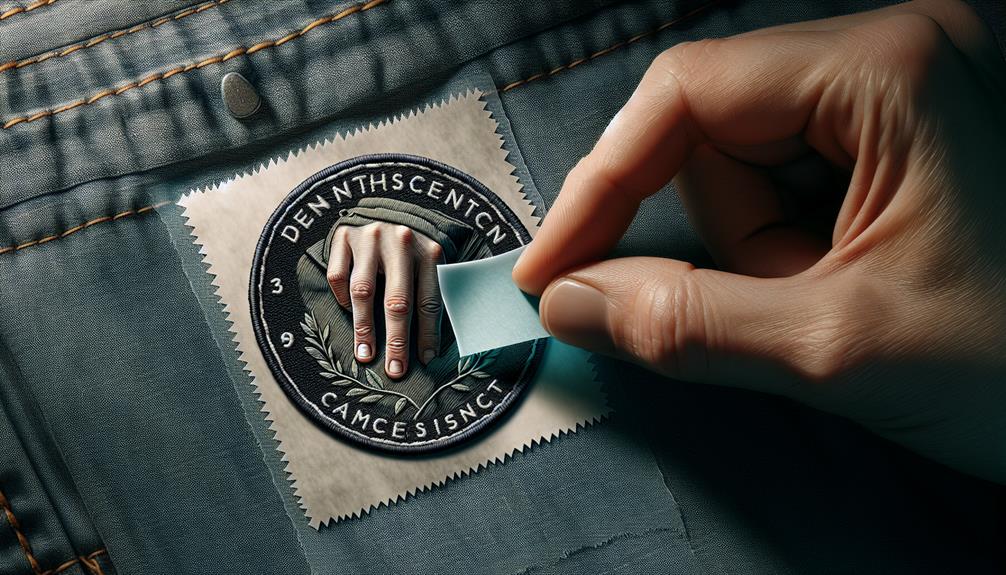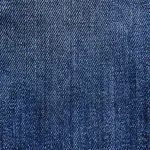Ever wondered how to determine if those patches you have are iron-on?
Well, I recently found myself in the same predicament, and the process can be quite puzzling.
The mystery behind whether patches are iron-on or not can be easily solved by paying attention to a few key indicators.
Let's explore some practical methods that can help unravel this patch conundrum and make sure you're on the right track with your patch application.
Table of Contents
Key Takeaways
- Look for shiny backing, precise stitching, vibrant colors, and label iron-on instructions.
- Follow manufacturer instructions for heat settings and consult professionals for application tips.
- Test patch durability with heat resistance and adhesive strength evaluations.
- Seek professional consultation for precise bonding methods and fabric compatibility insights.
Visual Inspection
Upon examining the patch closely, you can quickly determine if it's iron-on by noting specific characteristics such as a shiny adhesive backing and a smooth surface. A high-quality iron-on patch will have precise stitching that's secure and evenly spaced, ensuring longevity and durability. When inspecting the fabric texture, iron-on patches usually have a smoother feel compared to sew-on patches, as they're designed to adhere seamlessly to garments.
Color accuracy is another key aspect to take into account when identifying an iron-on patch. The colors should be vibrant and true to the original design, without any bleeding or fading. Additionally, checking the size dimensions is essential. Iron-on patches come in various sizes, so it's important to make sure that the patch fits the intended placement on your garment.
Check Label Information
To determine if patches are iron-on, it is important to check the label information provided on the packaging or backing of the patch. The label instructions will explicitly state whether the patch is meant to be ironed on or sewn. Additionally, the material composition of the patch will give you clues about its iron-on capabilities. Look for materials like polyester or a blend that is known to adhere well with heat.
| Label Instructions | Material Composition |
|---|---|
| Iron-On | Polyester |
| Sew On | Cotton |
| Heat Activated | Polyester Blend |
| Do Not Iron | Nylon |
| Machine Washable | Rayon |
Reading the label information carefully is important in ensuring the successful application of your patches. By following the provided instructions and understanding the material composition, you can confidently proceed with ironing on your patches.
Feel the Backing
Hey there!
When it comes to figuring out if patches are iron-on, feeling the backing can give you some clues.
Check for a shiny surface, test it with a magnet, and look out for any adhesive residue.
These simple steps can help you determine the patch type quickly and easily!
Check for Shiny Surface
When determining if patches are iron on, a simple way to do so is by feeling the backing to check for a shiny surface. A shiny surface usually indicates that the patch is designed to be ironed on. Here are some additional tips to take into account:
- Smoothness: Iron-on patches typically have a smoother backing compared to sew-on patches.
- Reflectiveness: The shiny surface may reflect light, making it easier to identify.
- Consistency: Iron-on patches tend to have a more consistent texture on the backing.
- Adhesive Feel: If the backing feels slightly sticky, it's likely an iron-on patch.
Test With Magnet
Feeling the backing of a patch with a magnet can help determine if it's iron-on. The magnetic properties of the backing can indicate its significance with fabric for iron-on application.
When testing with a magnet, if the patch is drawn to the magnet, it's likely to be iron-on. This importance is vital before applying the patch onto the fabric.
Look for Adhesive Residue
Upon examining the backing of a patch, check for any adhesive residue by feeling its texture. If you're unsure whether a patch is iron-on, closely inspect the backing for the following signs:
- Stickiness: Run your fingers over the backing to see if it feels sticky or tacky.
- Residue: Look for any leftover adhesive substance that might indicate it's an iron-on patch.
- Texture: Note the texture of the backing; iron-on patches often have a smoother feel due to the adhesive.
- Adhesive Smell: Sometimes, iron-on patches may have a faint adhesive smell when you bring them close to your nose.
Conduct a Burn Test
Hey there!
Let's talk about conducting a burn test to determine if patches are iron-on.
The burn test method involves carefully burning a small piece of the patch and observing the residue left behind.
It's a simple way to figure out the type of backing material used on the patch.
Burn Test Method
To determine if patches are iron on, you can utilize the burn test method by carefully burning a small piece of the patch to observe how it reacts to the flame. When conducting the burn test, be mindful of the following:
- Fabric type: Different fabrics burn in distinct ways, helping to identify the patch's composition.
- Brand authenticity: Some brands have specific materials or manufacturing processes, leading to unique burn patterns.
- Color changes: Note any color variations or residues left behind after burning, which can provide clues about the patch.
- Smell: Pay attention to any odors emitted during burning, as certain materials have distinctive smells when burned.
Observing Residue Left
When conducting a burn test to determine if patches are iron-on, observe the residue left behind after burning to gather clues about the patch's composition. The residue's characteristics can provide insights into the chemical composition and fabric type of the patch.
For example, if the residue is powdery and grey, it might indicate a synthetic fabric like polyester. On the other hand, if the residue forms a black, bead-like substance, it could suggest a natural fiber such as cotton.
Understanding the residue from the burn test can help you identify whether the patch is likely iron-on or not, based on the materials it's composed of. Conducting this simple test can provide valuable information about the patch's composition.
Consult Manufacturer Instructions
For the best guidance on determining if patches are iron-on, refer to the instructions provided by the manufacturer. Manufacturer instructions often contain valuable information that can help you understand the specifics of the patches you're working with. Here are some key points to look for:
- Heat Sensitivity: The manufacturer's instructions will typically mention the best heat setting for applying the patch. This information is important to make sure that the patch adheres correctly without damaging the fabric.
- Fabric Compatibility: Understanding which fabrics the patch is compatible with is essential to avoid any potential issues during the application process. The manufacturer will usually provide guidance on the types of fabrics that work best with the patch.
- Application Techniques: The instructions may include specific techniques for applying the patch, such as ironing duration, pressure, or whether to use a pressing cloth. Following these instructions can help achieve the best results.
- Care Instructions: Manufacturers often provide care tips to maintain the patch's longevity. This information can help you preserve the patch effectively.
Use a Magnet
After consulting the manufacturer instructions to determine if patches are iron-on, another simple way to check is by using a magnet. Magnets can help identify the presence of certain materials in the patch, indicating whether it is likely iron-on or not.
By examining the magnetic properties of the patch, we can gain insights into its adhesive strength and durability. Iron-on patches typically contain ferrous materials that are attracted to magnets. This magnetic attraction suggests that the patch is likely iron-on and can withstand the heat required for the adhesive to bond properly. Additionally, the heat importance of the materials used in the patch is essential for ensuring that it can withstand the ironing process without damage.
To better understand the connection between magnetic properties, heat resistance, adhesive strength, and durability in patches, let's examine the table below:
| Magnetic Properties | Heat Resistance | Adhesive Strength |
|---|---|---|
| Attracted to magnet | Important | Strong |
Test With Heat
Let's put the patch to the test with some heat to determine its bonding method. When testing patches with heat, there are a few key things to look out for:
- Heat Sensitivity: Apply moderate heat to a corner of the patch using an iron or heat press. If the patch starts to melt or burn, it isn't suitable for ironing on and likely has a different bonding method.
- Fabric Reaction: Observe how the fabric of the patch reacts to heat. If it curls or changes color considerably, it may not be intended for iron-on application.
- Patch Material: Different patch materials react differently to heat. Synthetic materials like polyester may melt under high heat, while natural fibers like cotton are more heat-resistant.
- Adhesive Strength: Check the patch's adhesive strength after applying heat. If the patch peels off easily or shows signs of weakening, it may not be iron-on.
Seek Professional Opinion
Wondering whether the patch is iron-on? Let's seek a professional opinion to confirm the best bonding method. When dealing with DIY projects, especially involving fabric identification, consulting a professional can guarantee the longevity of your patch attachment and save you time. Professionals have the experience and knowledge to determine the most suitable bonding method based on the patch material and fabric type. Here's a helpful table to guide you through understanding the importance of seeking professional advice:
| Why Seek Professional Opinion? | Benefits |
|---|---|
| Precision | Guarantees the right bonding method for your specific patch and fabric. |
| Durability | Enhances the longevity of your patch attachment, preventing premature detachment. |
| Expertise | Professionals provide insights and tips for successful patch applications. |
Seeking guidance from a professional can be invaluable for achieving optimal results in your patch application endeavors.
Consider Patch Material
Considering the material of your patch is critical in determining the appropriate bonding method for successful application. Different fabrics require specific techniques to make sure the patch adheres securely. Here are some essential points to keep in mind:
- Patch Design: The intricacy of the patch design can affect the bonding process. Detailed designs may require more delicate handling to prevent damage during application.
- Fabric Type: The type of fabric the patch is made from influences how it should be attached. Certain fabrics like denim or cotton may be more compatible with iron-on methods.
- Adhesive Compatibility: Some patches come with adhesive backing that's designed for iron-on application. It's important to match the adhesive type with the fabric for a lasting bond.
- Heat Sensitivity: Consider the fabric's heat sensitivity when choosing the bonding method. Delicate fabrics may require lower heat settings to prevent damage.
Understanding these factors will help you select the most suitable method to attach your patch securely while preserving its quality.
Frequently Asked Questions
Can Iron-On Patches Be Sewn Onto Clothing for Extra Security?
Yes, iron-on patches can be sewn onto clothing for extra security. It's one of the sewing alternatives to guarantee durability. When sewing them on, consider the patch placement carefully for both aesthetics and longevity of the attachment.
Are There Any Specific Types of Fabrics That Iron-On Patches Work Best On?
Certain fabrics like cotton and denim work best with iron-on patches due to their compatibility with the adhesive. To guarantee a secure bond, apply heat evenly with a hot iron on a dry, flat surface. Check the patch instructions for recommended heat settings.
How Long Does It Typically Take for an Iron-On Patch to Adhere to Fabric?
To guarantee iron-on patch durability, I follow instructions precisely, adjusting heat settings based on fabric type. Typically, the adhesion process takes about 20-30 seconds per section. Patience and a steady hand are key for a lasting bond.
Can Iron-On Patches Be Removed and Repositioned if Placed Incorrectly?
Yes, iron-on patches can usually be removed and repositioned if placed incorrectly. The removal process involves carefully peeling off the patch and reapplying heat. This flexibility allows for fixing errors and adjusting placement for a better result.
Are There Any Special Care Instructions for Clothing With Iron-On Patches Applied?
Iron on patch durability is important. To maintain, turn clothes inside out before washing. Use a gentle cycle and avoid high heat. Air dry or tumble dry low. With care, patches can stay secure for longer.
- Tetron Fabric for Marine Applications: Durability and Use Cases - June 18, 2025
- Tetron Fabric for Outdoor Furniture: Weather Resistance and Care - June 18, 2025
- Tetron Fabric for Wall Coverings: Style and Application Tips - June 18, 2025






